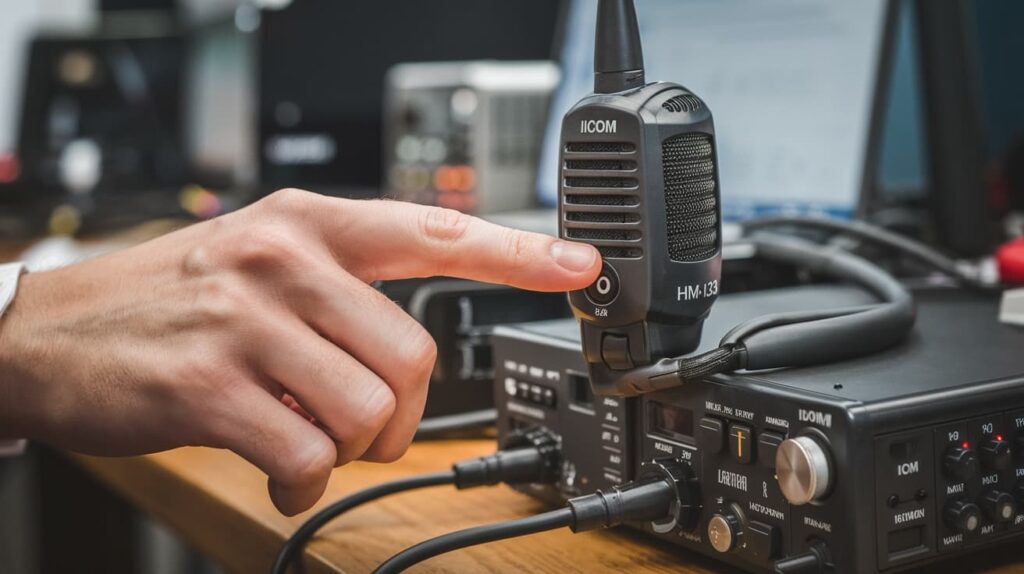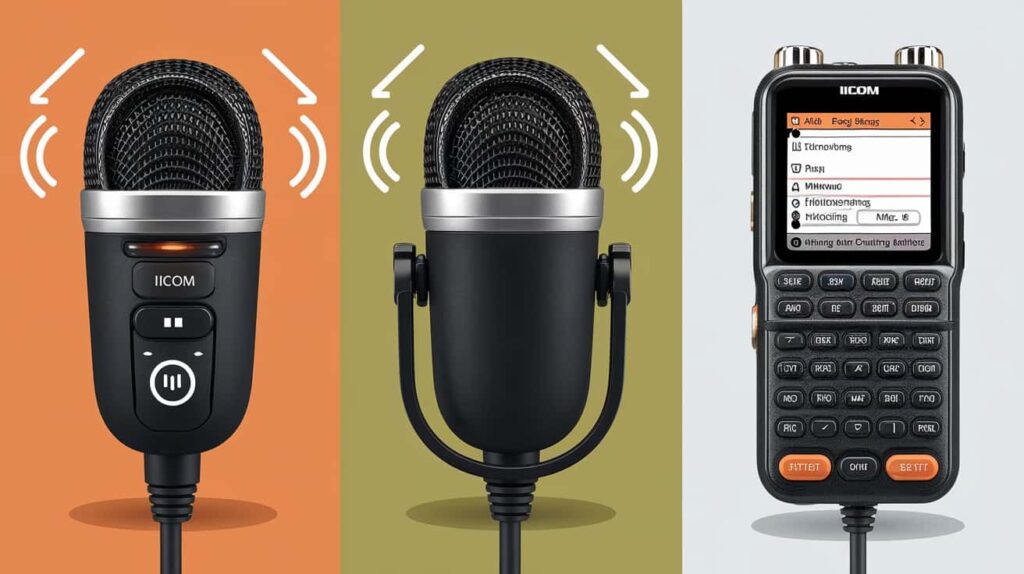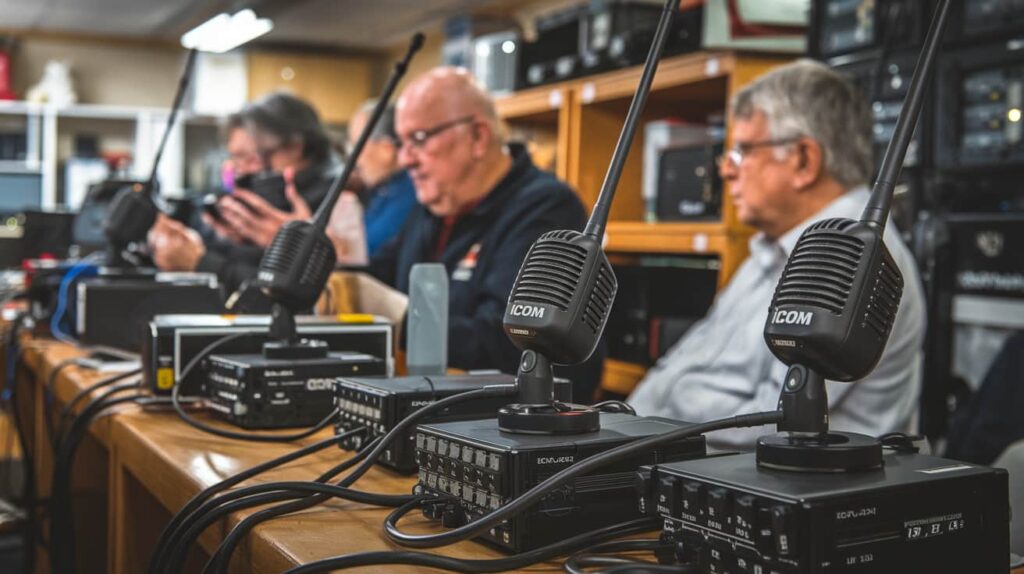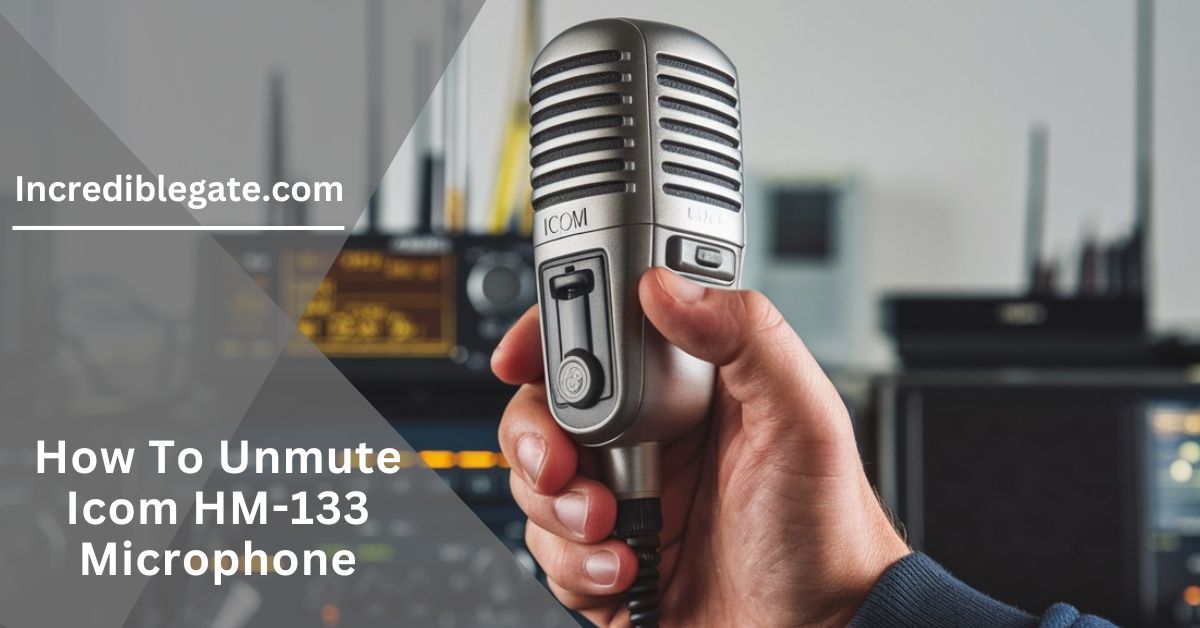The Icom HM-133 microphone is a reliable and user-friendly tool widely used by radio operators for clear communication. However, like many electronic devices, it can sometimes become muted, causing temporary communication issues. If you find yourself facing this problem, don’t worry—unmuting the Icom HM-133 microphone is easy to fix.
Stay tuned with us as we explore how to unmute Icom HM-133 microphone! We’ll share some easy steps and tips to get your mic to work perfectly again. Don’t miss out on our insights to ensure clear communication every time!
What Is The Icom HM-133 Microphone?
The Icom HM-133 microphone is highly regarded among radio operators for its reliability and user-friendly design, making it an excellent choice for beginners and seasoned users. Its lightweight construction and low error rate enhance operational efficiency during radio communications. However, new users may find the mute function somewhat confusing.

To help with this, the mute button is conveniently located for quick access. If you accidentally mute the mic, you can easily unmute it with a press. Also, checking that the microphone is properly connected to your transceiver can save you from potential communication hiccups.
Key Features And Mute Functionality – Learn How Your Icom HM-133 Works!
| Key Features | Description |
| Mute Button | Allows users to control audio transmission easily. A quick press can toggle the mute function. |
| Channel-Button Short | Engages a short to ground the transceiver body, reducing background noise during operation. |
| Compatibility | Designed to work with specific Icom transceiver models; ensure proper connection for optimal performance. |
| Troubleshooting Icon | Access microphone settings via the designated icon on the device to diagnose and resolve issues. |
| Lightweight Design | Easy to handle and carry, making it ideal for extended use during radio communications. |
Common Reasons For Microphone Muting – Find Out What’s Going Wrong!
Before diving into the unmuting process, it’s important to understand why the Icom HM-133 microphone could be muted in the first place. Here are some common reasons:
- Accidental Button Press: One of the most frequent causes of a muted microphone is the accidental press of the mute button. This can happen during handling or adjusting the microphone, especially in a busy setting.
- Incorrect Transceiver Settings: Sometimes, the settings on your transceiver may not be properly configured for the microphone. This could involve mute settings that must be adjusted to allow audio transmission.
- Software Glitches: Like any electronic device, software issues can occasionally arise. These glitches can affect the microphone’s performance, including the mute function.
- Hardware Malfunctions: Physical issues, such as a damaged microphone or cable, can cause the mic to remain muted. Inspecting the hardware for wear and tear is essential for troubleshooting.
- Interference from Other Devices: Nearby electronic devices can cause signal interference, which may disrupt the microphone’s functionality. Ensuring a clear space around your equipment can help maintain optimal performance.
How To Unmute Icom HM-133 Microphone? – A Step-By-Step Guide!
If you find your Icom HM-133 microphone muted and need to restore communication, follow these simple steps to unmute it effectively:
Locate The Mute Button:
- Find the Mute Button: The Icom HM-133 microphone has a dedicated mute button, typically on the front or side of the microphone.
- Press the Button: Gently press the mute button once. You should hear a click or see an indicator light confirming that the microphone is now unmuted.
Check The Transceiver Menu:
- Access the Menu: If pressing the mute button doesn’t work, access your transceiver’s menu. Use the buttons or knobs on your transceiver to navigate.
- Find Audio Settings: Look for options related to audio or microphone settings. This may vary depending on the model, so refer to your user manual if needed.
- Toggle Mute Setting: Locate the mute option and ensure it is set to “off.” Adjusting this setting should restore audio transmission.
Use The Function Key:
- Function Key Usage: Some Icom models allow you to assign a function key to toggle the mute on and off quickly. Check your user manual for this feature.
- Press the Function Key: If available, simply press the designated function key to unmute the microphone.

Reset The Microphone:
- Perform a Reset: If the microphone remains muted after trying the above steps, consider resetting it to factory settings.
- Follow Reset Instructions: Refer to your user manual for specific instructions on how to reset the microphone. This typically involves holding down certain buttons while powering on the device.
Check Connections:
- Inspect the Microphone Cable: Ensure the microphone cable is securely connected to the transceiver. Look for any signs of wear or damage that could affect performance.
- Reconnect if Necessary: If the connection seems loose or damaged, disconnect and reconnect the mic to see if that resolves the issue.
Test The Microphone:
- Conduct a Test: After unmuting, perform a test to ensure your microphone is functioning properly. Speak into the mic and check for audio transmission on your transceiver.
- Adjust Settings if Needed: If you still encounter issues, revisit your transceiver’s audio settings to ensure everything is configured correctly.
Try Additional Windows Key Combination:
- Use Windows Mic Icon: If you use the microphone with a Windows device, you can also try clicking on the microphone icon in your taskbar.
- Press Windows + Alt + K: This shortcut may toggle mute status on some systems.
Preventing Accidental Muting On The Icom HM-133 – You Must Read!
- Familiarize Yourself with Controls: Learn your microphone’s layout, especially the mute button’s location. Understanding where it is will help you avoid accidental presses during use.
- Use a Microphone Clip or Holder: Secure the microphone in a clip or holder when not used. This prevents movement that could inadvertently press the mute button and ensures the mic is safely stored.
- Lock the Mute Button (if available): Some Icom models allow you to lock or disable the mute button in settings. Check your user manual to see if this feature is available and enable it to prevent accidental activation.
- Implement a Routine Check: Before starting a communication session, make it a habit to check that the microphone is unmuted. A quick press of the button can confirm its status and prevent surprises.
- Label the Mute Button: If you use the microphone frequently, consider labelling the mute button with a small sticker or marker. This visual reminder can help keep you aware of its location and function.
- Use a Protective Case: Invest in a protective case for your microphone when transporting it. A case can prevent other items from pressing against the mute button, reducing the risk of accidental muting while on the go.
Advanced Tips For Icom HM-133 Microphone Users – Let’s See!
Optimize Audio Clarity With Transceiver Settings:
Adjust the audio settings on your transceiver to fine-tune the microphone’s clarity. Experiment with mic gain and audio levels for a balanced sound that fits your communication style. This can reduce background noise and improve the clarity of your transmission.
Customize Function Keys For Quick Access:
Many Icom transceivers allow you to assign custom functions to buttons on the microphone or transceiver. For example, you can set up a function key to toggle mute or adjust volume quickly. This shortcut can save time during active sessions and prevent accidental settings changes.
Use A Noise Filter For Cleaner Audio:
Consider enabling noise reduction or filter settings on compatible transceivers to minimise background sounds. This can be especially useful if you’re operating in noisy environments. With reduced ambient noise, your voice will come through more clearly.

Practice Safe Cable Management:
Regularly inspect and manage your microphone cable to prevent wear and accidental disconnections. Using cable clips or covers can reduce strain on the connection and help prevent accidental muting or audio cutouts. Proper cable care prolongs the lifespan of your microphone.
Utilize The Lock Function On The Mute Button:
Some models allow you to lock the mute button to prevent accidental activation during transmission. Check your manual to see if this feature is available and use it in busy settings. This lock function is handy for avoiding disruptions in critical communication sessions.
Regularly Update Firmware For Enhanced Performance:
Firmware updates from Icom may improve mic performance, including mute functions, audio quality, and compatibility. Check for updates periodically and follow installation instructions to keep your microphone and transceiver in top shape. Regular updates ensure you’re benefiting from the latest optimizations.
FAQs:
Why does my Icom HM-133 microphone keep muting itself?
Accidental button presses, software glitches, or electronic interference may be causing this issue. Regular maintenance and careful handling can help prevent these automatic mute triggers, ensuring a smoother experience with your mic.
Can I disable the mute function on my Icom HM-133 microphone?
You can’t fully disable the mute function, but many transceivers have a lock setting to prevent accidental muting when not needed. This lock can be a lifesaver during critical transmissions to avoid interruptions.
Is it normal for the Icom HM-133 microphone to slightly delay when unmuting?
Due to software processing speed, a slight delay might occur. If this becomes problematic, try rebooting or resetting the transceiver to improve responsiveness and ensure seamless communication.
Can extreme temperatures affect the mute function of my Icom HM-133 microphone?
Yes, extreme temperatures can impact mic performance. To maintain its longevity and optimal function, the mic must always be operated and stored within the recommended temperature range in the manual.
How can I test if my Icom HM-133 microphone works correctly after unmuting?
Perform a test broadcast or use the transceiver’s monitor function to confirm the microphone is transmitting audio. Regular testing helps catch issues early, keeping your setup reliable.
Are there third-party tools to diagnose muting issues with the Icom HM-133 microphone?
While some general diagnostic tools are available, it’s best to use the diagnostic features within the Icom transceiver itself, as these ensure accuracy and compatibility. Manufacturer tools are designed to give you the best insights into your equipment’s condition.
Can software-defined radios (SDRs) help troubleshoot Icom HM-133 microphone issues?
SDRs offer audio analysis tools but aren’t a primary resource for troubleshooting mic issues. Use your transceiver’s built-in diagnostics for more reliable results explicitly tailored for Icom equipment.
Conclusion:
Learning how to unmute Icom HM-133 microphone is straightforward once you know the steps. Checking the physical mute button, adjusting transceiver settings, and using the function keys can quickly resolve muting issues.
Regular maintenance and updating of your transceiver firmware also help prevent future problems. With these simple practices, you can ensure smooth, uninterrupted communication. Following these tips means you’ll always be ready to transmit clearly with your Icom HM-133 microphone.
Also Read:

